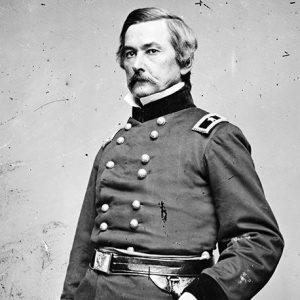calsfoundation@cals.org
Willis Arnold Gorman (1816–1876)
Willis Arnold Gorman was a politician and soldier who briefly commanded the District of Eastern Arkansas during the Civil War.
Willis Arnold Gorman was born on January 12, 1816, near Flemingsburg, Kentucky, to David Gorman and Elizabeth McCart Gorman. The family moved to Bloomington, Indiana, in 1835, and his political career began when he served as clerk of the Indiana State Senate in 1837–1838. He then was elected to the Indiana legislature, serving three terms in the House from 1841 to 1844. He graduated from Indiana University’s law school in 1845 and began practicing law in Bloomington.
He married Martha Stone in 1836. They had five children. She died on March 3, 1861, and he married Emily Newington in 1865.
During the Mexican War, Gorman enlisted as a private in the Third Indiana Volunteers on June 22, 1846, and was promoted to major four days later; he fought in the Battle of Buena Vista in February 1847. When that regiment’s enlistment expired, he raised the Fourth Indiana Volunteer Infantry and was made its colonel on June 16, 1847. The Fourth was involved in the siege of Puebla. Gorman mustered out of service on July 28, 1848.
Returning to Indiana, Gorman was elected as a Democrat to serve in the U.S. House of Representatives from March 4, 1849, to March 3, 1853. He moved to Minnesota that same year and was appointed territorial governor by President Franklin Pierce, serving in that role from 1853 to 1857. He took part in the 1857 Minnesota constitutional convention and served in the state House of Representatives from 1857 to 1859. Gorman was a presidential elector for Stephen A. Douglas in 1860. He also had a legal practice in St. Paul, Minnesota, from 1857 to 1861.
When the Civil War began, Gorman was commissioned as colonel of the First Minnesota Volunteer Infantry Regiment on April 29, 1861. He earned praise for its conduct at the Battle of First Manassas in Virginia. After serving in the disastrous Battle of Ball’s Bluff, Virginia, he was promoted to brigadier general on September 7, 1861.
Gorman again was commended for his actions in the Battle of Seven Pines during the Peninsular Campaign, and he led a brigade in the savage fighting at Antietam, Maryland. On November 1, 1862, he was placed in command of a division whose leader was wounded at Antietam.
Two weeks later, on November 14, 1862, he was ordered to report to Major General Samuel R. Curtis in St. Louis, Missouri, and on December 3, he was placed in command of the District of Eastern Arkansas, where most of his efforts were spent in supporting ongoing Union operations against the Confederate stronghold at Vicksburg, Mississippi. Gorman operated from Helena (Phillips County).
The primary Arkansas military operation in which Gorman was involved was the January 13–19, 1863, White River Expedition, which he undertook to build on the Union victory in the engagement at Arkansas Post a few days earlier. Working with Admiral David Dixon Porter, Gorman amassed troops from his Helena garrison and—with gunboats USS Cincinnati, Romeo, Baron DeKalb, and Forest Rose—moved up the White River. The expedition resulted in the capture of St. Charles (Arkansas County), DeValls Bluff (Prairie County), and Des Arc (Prairie County) along with considerable prisoners and materiel, but failed to capture the steamboat Blue Wing. Gorman also determined that weather conditions precluded an advance on Little Rock (Pulaski County), citing a “sea of mud and water intervening between that place and DeVall’s [sic] Bluff.”
Despite the relative success of the White River expedition, Gorman’s district command was short-lived. On January 22, 1863, all of the troops in eastern Arkansas were “temporarily attached to the Department of the Tennessee” and placed under John A. McClernand’s Thirteenth Army Corps. Curtis, unsure of what General Ulysses S. Grant was planning for the district, wrote that “I suppose General Gorman will go below” and “I suppose General Grant has made new arrangements, which I hope will quiet new difficulties and complications which have accumulated in Eastern Arkansas,” mentioning rumors that Gorman had been involved in cotton speculation. Benjamin Mayberry Prentiss took command of the District of Eastern Arkansas on March 13, 1863, and Gorman remained in the area, taking part in some of the operations against Vicksburg before mustering out of service on May 4, 1864.
He resumed his law practice in St. Paul after the war and served as the city’s prosecuting attorney from 1869 to 1875. He died at St. Paul on May 20, 1876, and is buried in Oakland Cemetery there.
For additional information:
“Willis Arnold Gorman.” Find a Grave. https://www.findagrave.com/memorial/5892341/willis_arnold-gorman (accessed October 3, 2025).
Biographical Directory of the American Congress, 1774–1961. Washington DC: U.S. Government Printing Office, 1961.
Christ, Mark K. Civil War Arkansas, 1863: The Battle for a State. Norman: University of Oklahoma Press, 2010.
Heitman, Francis B. Historical Register and Dictionary of the United States Army, 1789–1903. Vol. 1. Washington DC: U.S. Government Printing Office,1903.
Moe, Richard. The Last Full Measure of Devotion: The Life and Death of the First Minnesota Volunteers. New York: Henry Holt and Company, 1993.
Records of Territorial Governor Willis A. Gorman. Minnesota Historical Society, St. Paul, Minnesota.
The War of the Rebellion: A Compilation of the Official Records of the Union and Confederate Armies. Vol. 13, p. 793. Washington DC: Government Printing Office, 1885.
The War of the Rebellion: A Compilation of the Official Records of the Union and Confederate Armies. Series 1, Vol. 22, parts 1 and 2. Washington DC: Government Printing Office, 1888.
Warner, Ezra. Generals in Blue. Baton Rouge: Louisiana State University Press, 1964.
Willis A. Gorman and Family Papers. Minnesota Historical Society, St. Paul, Minnesota.
Mark K. Christ
Little Rock, Arkansas
 Willis A. Gorman
Willis A. Gorman 



Comments
No comments on this entry yet.